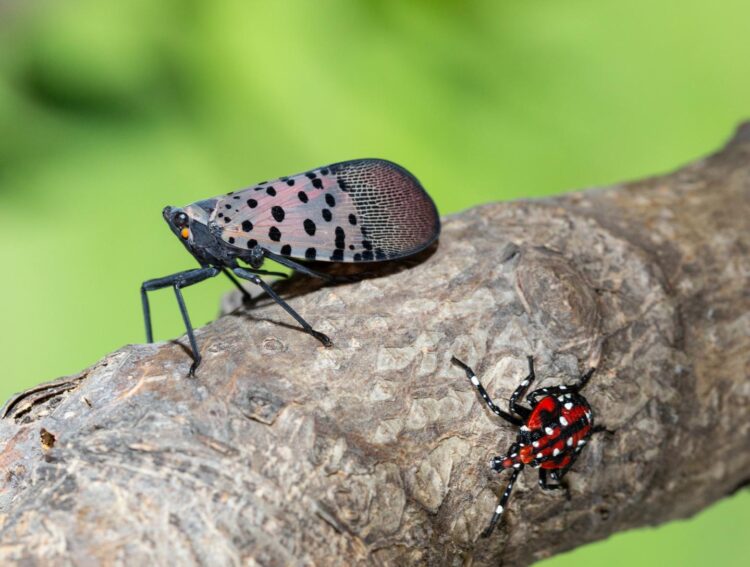New collection showcases growing body of knowledge on spotted lanternfly biology and management

Credit: Stephen Ausmus, U.S. Department of Agriculture-Agricultural Research Service, public domain
Annapolis, MD; February 17, 2021–When the invasive spotted lanternfly arrived in the United States in 2014, it was immediately recognized for the threat it posed to native plants and crops. A community of researchers and experts in science, agriculture, and government sprang into action to respond, improving our chances for containing the pest and curbing its potential for damage.
While the effort continues, a new collection curated by the Entomological Society of America’s family of journals showcases the growing body of research that is helping us understand the spotted lanternfly’s biology and how to contain it. The collection features 25 articles published in ESA journals since 2015, with 16 of them new additions since June 2020.
The spotted lanternfly (Lycorma delicatula) is a treehopper native to Asia but was discovered in Pennsylvania in 2014, and it has since spread to five other northeastern states. Its primary host is tree of heaven (Ailanthus altissima), but it is known to feed on more than 100 types of plants–mostly trees, shrubs, and stout vines. Valuable crops the spotted lanternfly can damage include grapes, apples, and peaches, as well as hardwood trees. One study of the lanternfly’s potential range in the U.S., based on environmental and climatic conditions, suggests most of New England and the mid-Atlantic states as well as parts of the central U.S. and Pacific Northwest are vulnerable to establishment of the spotted lanternfly if it finds its way there.
Melody Keena, Ph.D., research entomologist at the U.S. Forest Service, is co-editor-in-chief of the ESA journal Environmental Entomology and compiled the collection on spotted lanternfly. Like many, Keena was struck by the insect’s potential when she first learned about it. “I was surprised because it is so much bigger than the treehoppers that are native. I was also surprised by the large numbers congregating on single trees,” she says.
Early on, the U.S. Department of Agriculture’s Animal Plant Health Inspection Service and the state of Pennsylvania led the charge, says Keena, while more states and groups have joined in as the spotted lanternfly has spread.
“Both federal and university groups–with Pennsylvania State University taking the early lead–have developed a lot of knowledge and tools rapidly for dealing with this pest, as this collection demonstrates,” Keena says.
Engaging the public has been critical as well.
“The public has taken an interest in it because of the major nuisance the adults are in the fall, with all the honey dew the lanternflies produce and black sooty mold that grows on it,” Keena says. “They are willing to help in any way they can, like removing its egg masses or smashing adults they find or allowing researchers to use their property.”
The research collection showcases progress made so far, as continued awareness and research will be necessary to slow the spotted lanternfly’s spread.
“Multiple tools for trapping and killing spotted lanternfly have been developed but still need improvement, especially for adults. Biological control organisms have been found and are being evaluated. Prospects for managing it are good,” says Keena. “We don’t yet know how far it will successfully be able to spread, but there are indications that it may have some climatic limitations. Current work to understand how humans are aiding its spread, and how to cut off those avenues, is underway.”
###
The ESA spotted lanternfly collection is available at http://www.
CONTACT: Joe Rominiecki, [email protected], 301-731-4535 x3009
ABOUT: ESA is the largest organization in the world serving the professional and scientific needs of entomologists and people in related disciplines. Founded in 1889, ESA today has more than 7,000 members affiliated with educational institutions, health agencies, private industry, and government. Headquartered in Annapolis, Maryland, the Society stands ready as a non-partisan scientific and educational resource for all insect-related topics. ESA publishes eight internationally acclaimed journals that provide unsurpassed coverage of the broad science of entomology, as well as the quarterly magazine American Entomologist. For more information, visit http://www.
Media Contact
Joe Rominiecki
[email protected]
Original Source
https:/





